Report on Costs, Revenues, and Costing Systems at Marks and Spencer
VerifiedAdded on 2020/10/23
|18
|3394
|70
Report
AI Summary
This report provides a comprehensive analysis of costs and revenues within Marks and Spencer (M&S), a major British retailer. It begins by exploring the nature of costing systems, their role, and their significance within the organization, including internal reporting and different costing methods like historical, absorption, direct, and marginal costing. The report then evaluates cost information, including recording, analysis, and the different stages of inventory valuation using FIFO method. Furthermore, it examines cost apportionment, overhead costs, and calculation methods. The report also delves into budget deviations, variance analysis, and the presentation of information for budget holders. Finally, it assesses the application of costing systems in decision-making, including estimating future income and the impact of changing activity levels on unit costs, offering valuable insights into the financial operations of M&S.
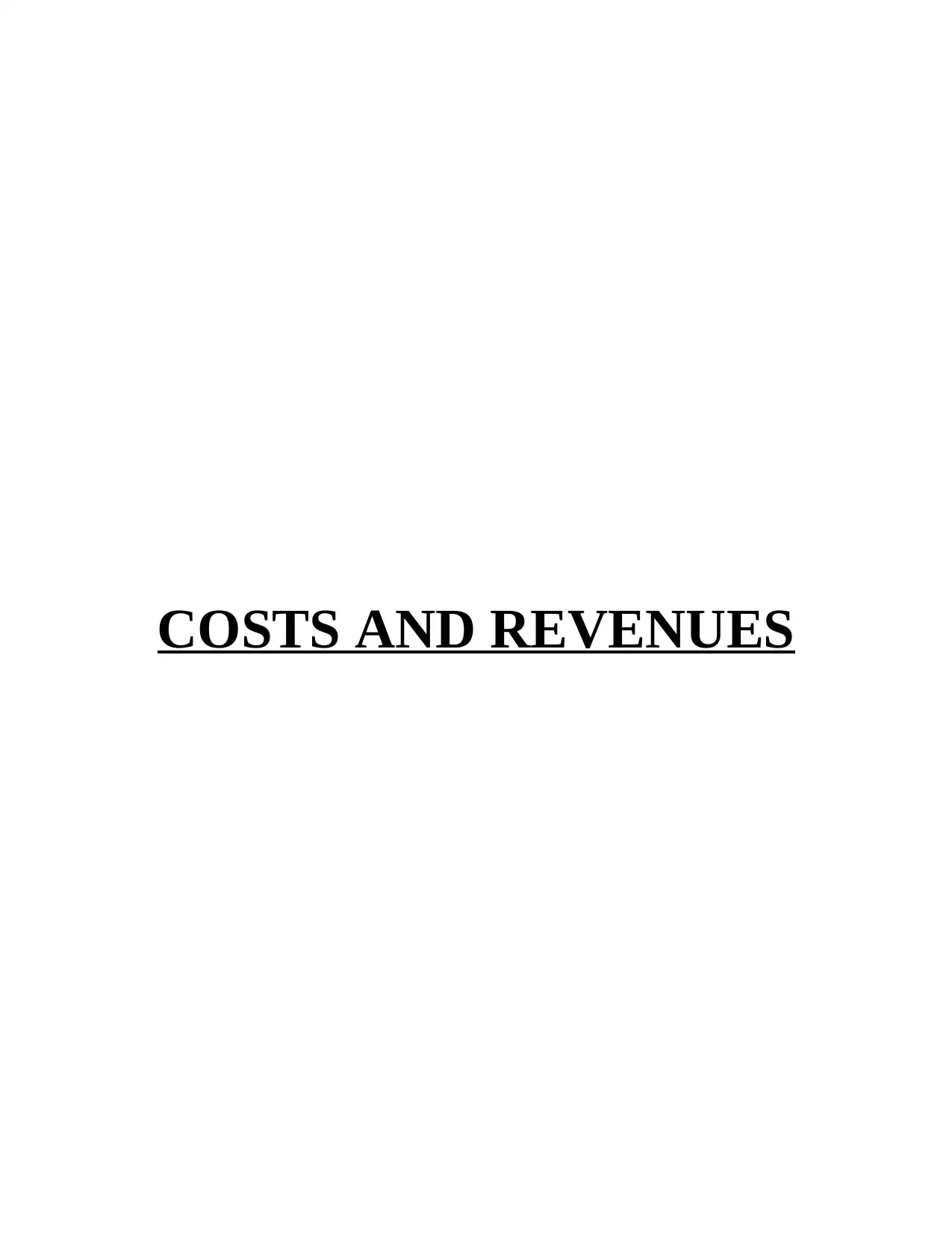
COSTS AND REVENUES
Paraphrase This Document
Need a fresh take? Get an instant paraphrase of this document with our AI Paraphraser
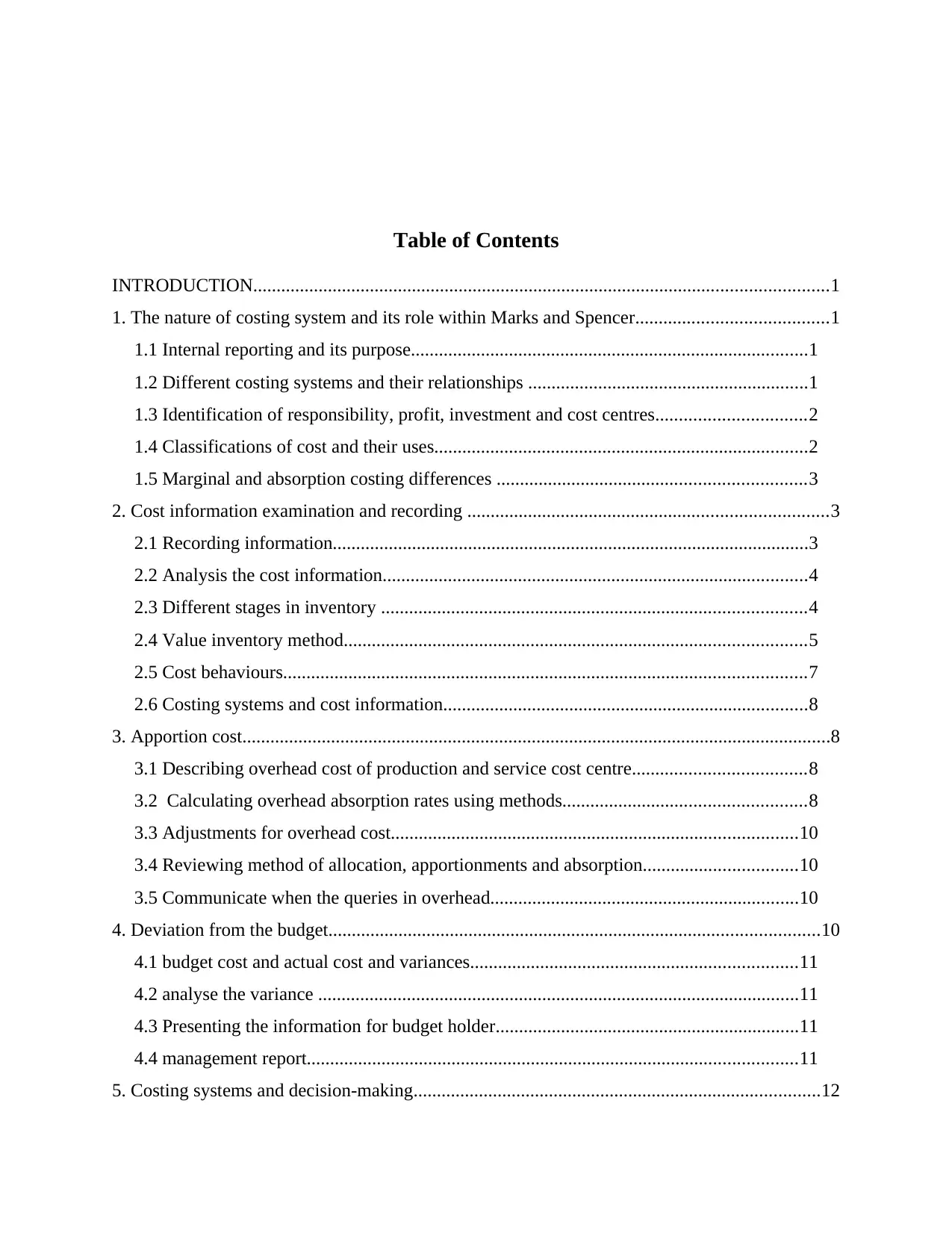
Table of Contents
INTRODUCTION...........................................................................................................................1
1. The nature of costing system and its role within Marks and Spencer.........................................1
1.1 Internal reporting and its purpose.....................................................................................1
1.2 Different costing systems and their relationships ............................................................1
1.3 Identification of responsibility, profit, investment and cost centres................................2
1.4 Classifications of cost and their uses................................................................................2
1.5 Marginal and absorption costing differences ..................................................................3
2. Cost information examination and recording .............................................................................3
2.1 Recording information......................................................................................................3
2.2 Analysis the cost information...........................................................................................4
2.3 Different stages in inventory ...........................................................................................4
2.4 Value inventory method...................................................................................................5
2.5 Cost behaviours................................................................................................................7
2.6 Costing systems and cost information..............................................................................8
3. Apportion cost..............................................................................................................................8
3.1 Describing overhead cost of production and service cost centre.....................................8
3.2 Calculating overhead absorption rates using methods....................................................8
3.3 Adjustments for overhead cost.......................................................................................10
3.4 Reviewing method of allocation, apportionments and absorption.................................10
3.5 Communicate when the queries in overhead..................................................................10
4. Deviation from the budget.........................................................................................................10
4.1 budget cost and actual cost and variances......................................................................11
4.2 analyse the variance .......................................................................................................11
4.3 Presenting the information for budget holder.................................................................11
4.4 management report.........................................................................................................11
5. Costing systems and decision-making.......................................................................................12
INTRODUCTION...........................................................................................................................1
1. The nature of costing system and its role within Marks and Spencer.........................................1
1.1 Internal reporting and its purpose.....................................................................................1
1.2 Different costing systems and their relationships ............................................................1
1.3 Identification of responsibility, profit, investment and cost centres................................2
1.4 Classifications of cost and their uses................................................................................2
1.5 Marginal and absorption costing differences ..................................................................3
2. Cost information examination and recording .............................................................................3
2.1 Recording information......................................................................................................3
2.2 Analysis the cost information...........................................................................................4
2.3 Different stages in inventory ...........................................................................................4
2.4 Value inventory method...................................................................................................5
2.5 Cost behaviours................................................................................................................7
2.6 Costing systems and cost information..............................................................................8
3. Apportion cost..............................................................................................................................8
3.1 Describing overhead cost of production and service cost centre.....................................8
3.2 Calculating overhead absorption rates using methods....................................................8
3.3 Adjustments for overhead cost.......................................................................................10
3.4 Reviewing method of allocation, apportionments and absorption.................................10
3.5 Communicate when the queries in overhead..................................................................10
4. Deviation from the budget.........................................................................................................10
4.1 budget cost and actual cost and variances......................................................................11
4.2 analyse the variance .......................................................................................................11
4.3 Presenting the information for budget holder.................................................................11
4.4 management report.........................................................................................................11
5. Costing systems and decision-making.......................................................................................12
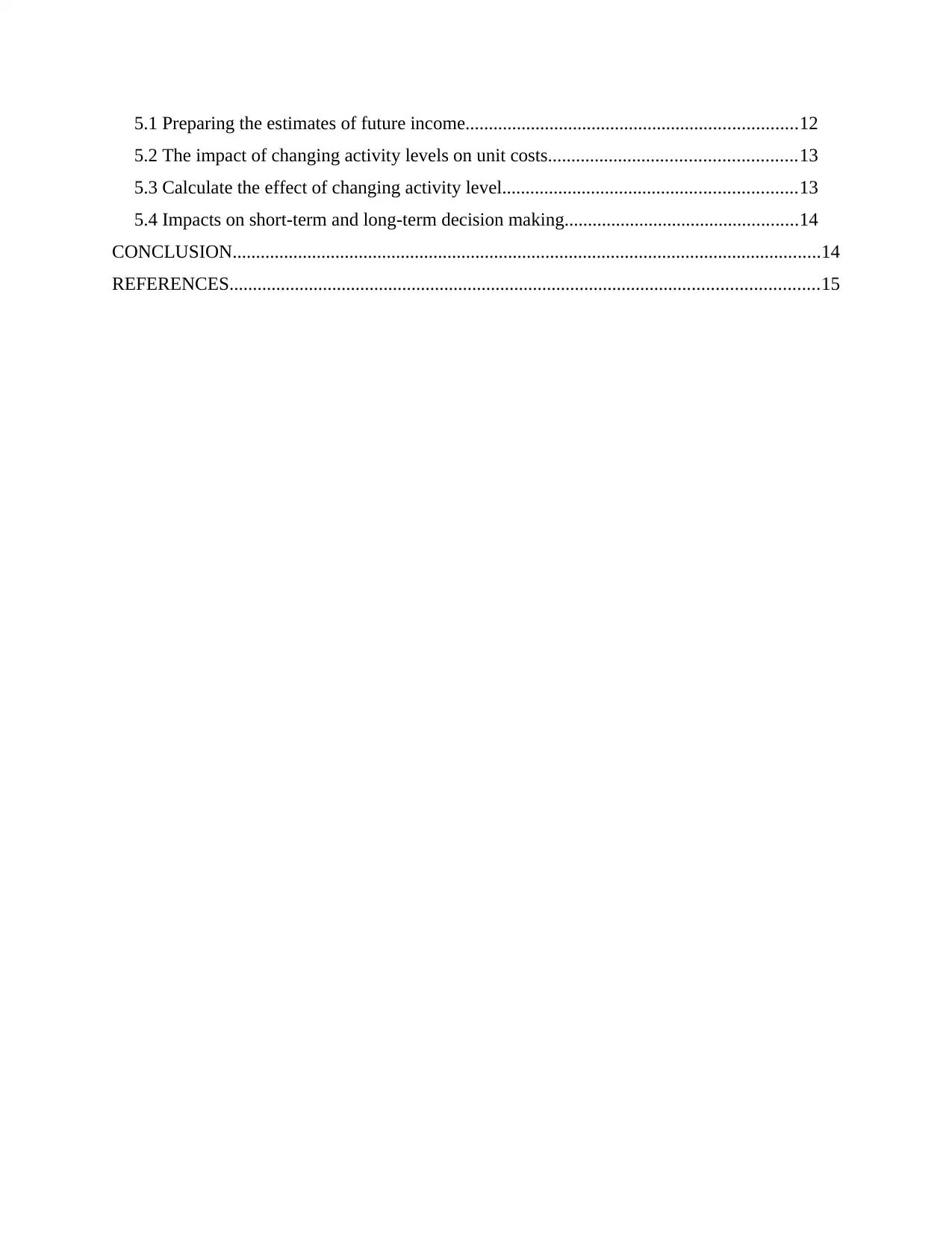
5.1 Preparing the estimates of future income.......................................................................12
5.2 The impact of changing activity levels on unit costs.....................................................13
5.3 Calculate the effect of changing activity level...............................................................13
5.4 Impacts on short-term and long-term decision making..................................................14
CONCLUSION..............................................................................................................................14
REFERENCES..............................................................................................................................15
5.2 The impact of changing activity levels on unit costs.....................................................13
5.3 Calculate the effect of changing activity level...............................................................13
5.4 Impacts on short-term and long-term decision making..................................................14
CONCLUSION..............................................................................................................................14
REFERENCES..............................................................................................................................15
⊘ This is a preview!⊘
Do you want full access?
Subscribe today to unlock all pages.

Trusted by 1+ million students worldwide
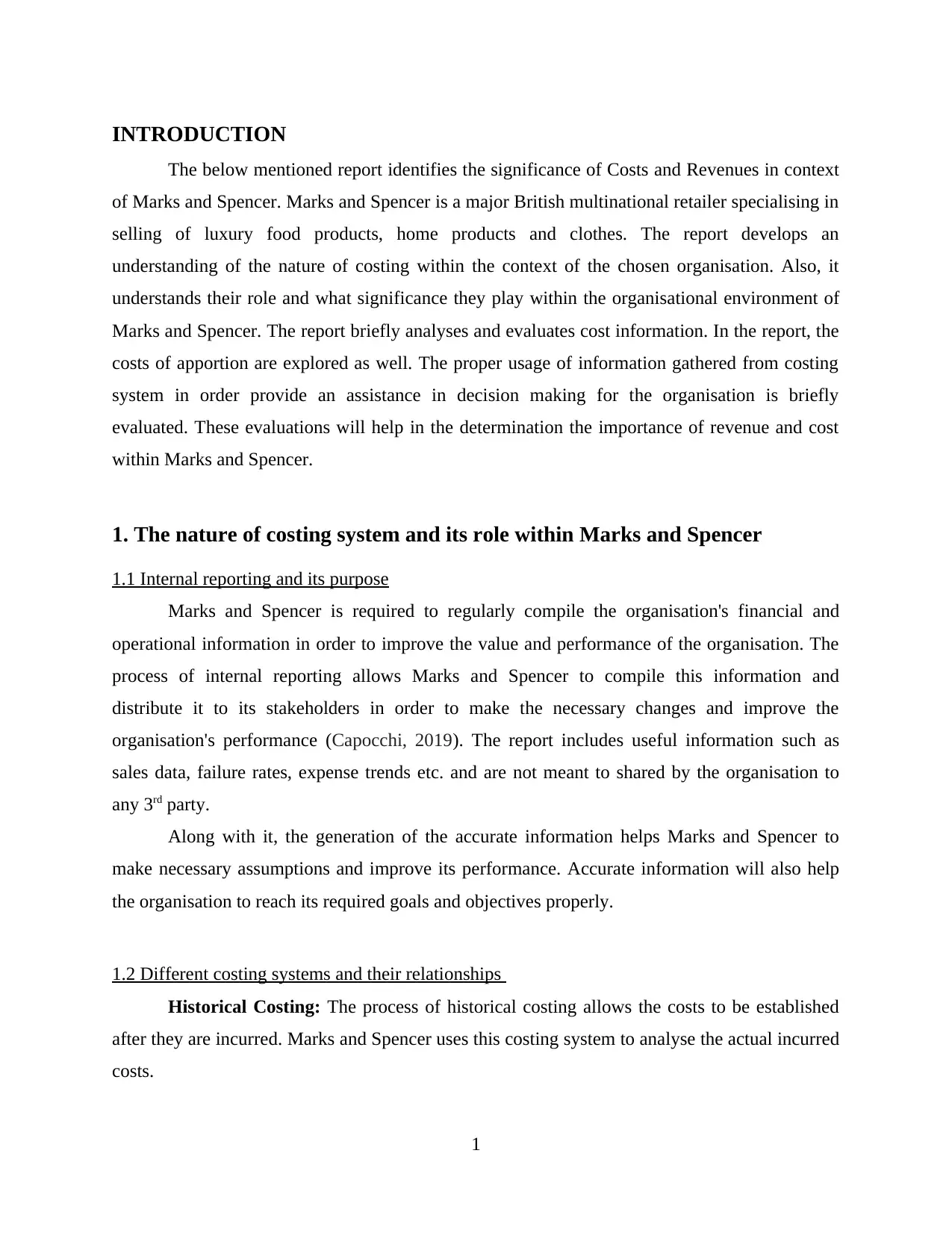
INTRODUCTION
The below mentioned report identifies the significance of Costs and Revenues in context
of Marks and Spencer. Marks and Spencer is a major British multinational retailer specialising in
selling of luxury food products, home products and clothes. The report develops an
understanding of the nature of costing within the context of the chosen organisation. Also, it
understands their role and what significance they play within the organisational environment of
Marks and Spencer. The report briefly analyses and evaluates cost information. In the report, the
costs of apportion are explored as well. The proper usage of information gathered from costing
system in order provide an assistance in decision making for the organisation is briefly
evaluated. These evaluations will help in the determination the importance of revenue and cost
within Marks and Spencer.
1. The nature of costing system and its role within Marks and Spencer
1.1 Internal reporting and its purpose
Marks and Spencer is required to regularly compile the organisation's financial and
operational information in order to improve the value and performance of the organisation. The
process of internal reporting allows Marks and Spencer to compile this information and
distribute it to its stakeholders in order to make the necessary changes and improve the
organisation's performance (Capocchi, 2019). The report includes useful information such as
sales data, failure rates, expense trends etc. and are not meant to shared by the organisation to
any 3rd party.
Along with it, the generation of the accurate information helps Marks and Spencer to
make necessary assumptions and improve its performance. Accurate information will also help
the organisation to reach its required goals and objectives properly.
1.2 Different costing systems and their relationships
Historical Costing: The process of historical costing allows the costs to be established
after they are incurred. Marks and Spencer uses this costing system to analyse the actual incurred
costs.
1
The below mentioned report identifies the significance of Costs and Revenues in context
of Marks and Spencer. Marks and Spencer is a major British multinational retailer specialising in
selling of luxury food products, home products and clothes. The report develops an
understanding of the nature of costing within the context of the chosen organisation. Also, it
understands their role and what significance they play within the organisational environment of
Marks and Spencer. The report briefly analyses and evaluates cost information. In the report, the
costs of apportion are explored as well. The proper usage of information gathered from costing
system in order provide an assistance in decision making for the organisation is briefly
evaluated. These evaluations will help in the determination the importance of revenue and cost
within Marks and Spencer.
1. The nature of costing system and its role within Marks and Spencer
1.1 Internal reporting and its purpose
Marks and Spencer is required to regularly compile the organisation's financial and
operational information in order to improve the value and performance of the organisation. The
process of internal reporting allows Marks and Spencer to compile this information and
distribute it to its stakeholders in order to make the necessary changes and improve the
organisation's performance (Capocchi, 2019). The report includes useful information such as
sales data, failure rates, expense trends etc. and are not meant to shared by the organisation to
any 3rd party.
Along with it, the generation of the accurate information helps Marks and Spencer to
make necessary assumptions and improve its performance. Accurate information will also help
the organisation to reach its required goals and objectives properly.
1.2 Different costing systems and their relationships
Historical Costing: The process of historical costing allows the costs to be established
after they are incurred. Marks and Spencer uses this costing system to analyse the actual incurred
costs.
1
Paraphrase This Document
Need a fresh take? Get an instant paraphrase of this document with our AI Paraphraser
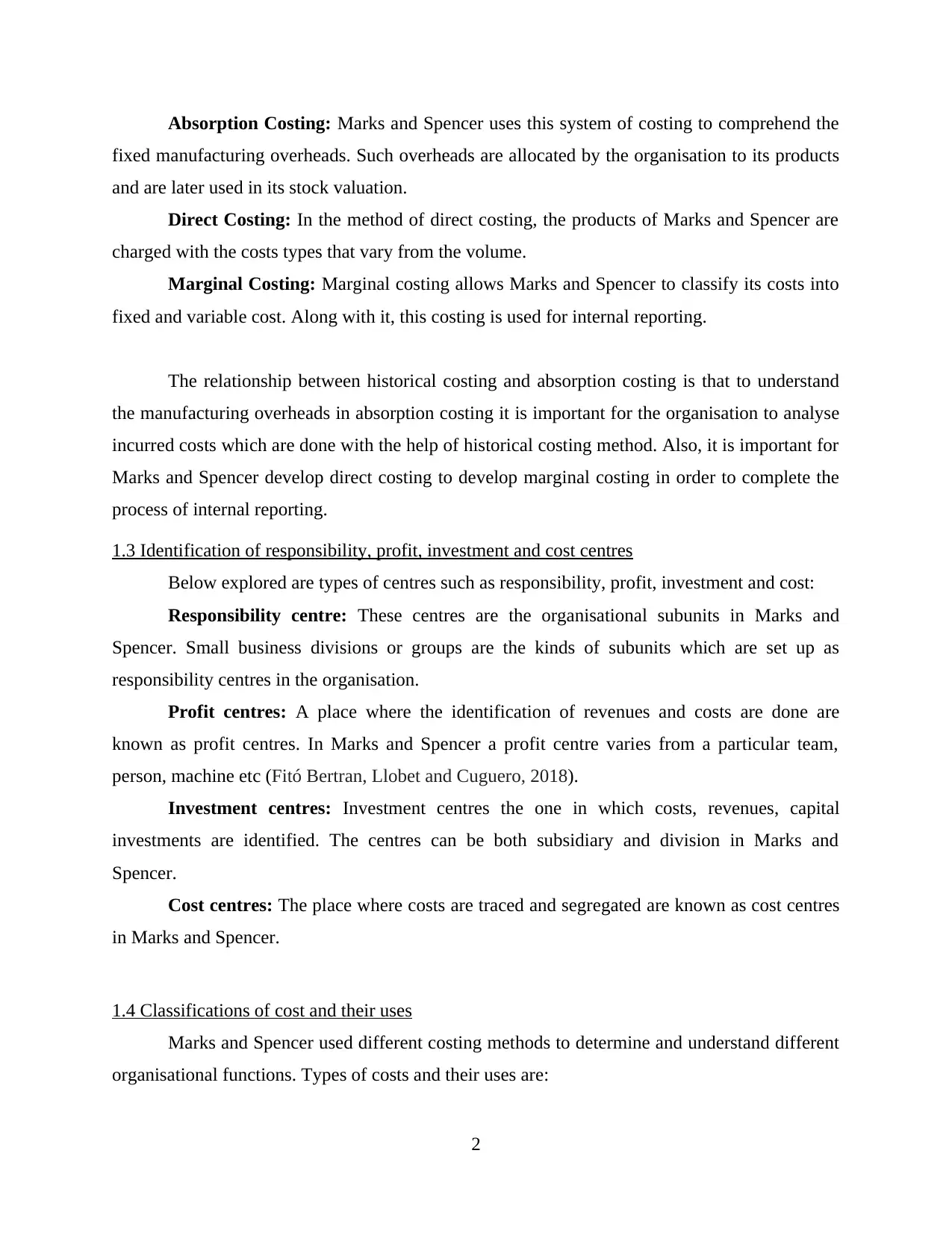
Absorption Costing: Marks and Spencer uses this system of costing to comprehend the
fixed manufacturing overheads. Such overheads are allocated by the organisation to its products
and are later used in its stock valuation.
Direct Costing: In the method of direct costing, the products of Marks and Spencer are
charged with the costs types that vary from the volume.
Marginal Costing: Marginal costing allows Marks and Spencer to classify its costs into
fixed and variable cost. Along with it, this costing is used for internal reporting.
The relationship between historical costing and absorption costing is that to understand
the manufacturing overheads in absorption costing it is important for the organisation to analyse
incurred costs which are done with the help of historical costing method. Also, it is important for
Marks and Spencer develop direct costing to develop marginal costing in order to complete the
process of internal reporting.
1.3 Identification of responsibility, profit, investment and cost centres
Below explored are types of centres such as responsibility, profit, investment and cost:
Responsibility centre: These centres are the organisational subunits in Marks and
Spencer. Small business divisions or groups are the kinds of subunits which are set up as
responsibility centres in the organisation.
Profit centres: A place where the identification of revenues and costs are done are
known as profit centres. In Marks and Spencer a profit centre varies from a particular team,
person, machine etc (Fitó Bertran, Llobet and Cuguero, 2018).
Investment centres: Investment centres the one in which costs, revenues, capital
investments are identified. The centres can be both subsidiary and division in Marks and
Spencer.
Cost centres: The place where costs are traced and segregated are known as cost centres
in Marks and Spencer.
1.4 Classifications of cost and their uses
Marks and Spencer used different costing methods to determine and understand different
organisational functions. Types of costs and their uses are:
2
fixed manufacturing overheads. Such overheads are allocated by the organisation to its products
and are later used in its stock valuation.
Direct Costing: In the method of direct costing, the products of Marks and Spencer are
charged with the costs types that vary from the volume.
Marginal Costing: Marginal costing allows Marks and Spencer to classify its costs into
fixed and variable cost. Along with it, this costing is used for internal reporting.
The relationship between historical costing and absorption costing is that to understand
the manufacturing overheads in absorption costing it is important for the organisation to analyse
incurred costs which are done with the help of historical costing method. Also, it is important for
Marks and Spencer develop direct costing to develop marginal costing in order to complete the
process of internal reporting.
1.3 Identification of responsibility, profit, investment and cost centres
Below explored are types of centres such as responsibility, profit, investment and cost:
Responsibility centre: These centres are the organisational subunits in Marks and
Spencer. Small business divisions or groups are the kinds of subunits which are set up as
responsibility centres in the organisation.
Profit centres: A place where the identification of revenues and costs are done are
known as profit centres. In Marks and Spencer a profit centre varies from a particular team,
person, machine etc (Fitó Bertran, Llobet and Cuguero, 2018).
Investment centres: Investment centres the one in which costs, revenues, capital
investments are identified. The centres can be both subsidiary and division in Marks and
Spencer.
Cost centres: The place where costs are traced and segregated are known as cost centres
in Marks and Spencer.
1.4 Classifications of cost and their uses
Marks and Spencer used different costing methods to determine and understand different
organisational functions. Types of costs and their uses are:
2
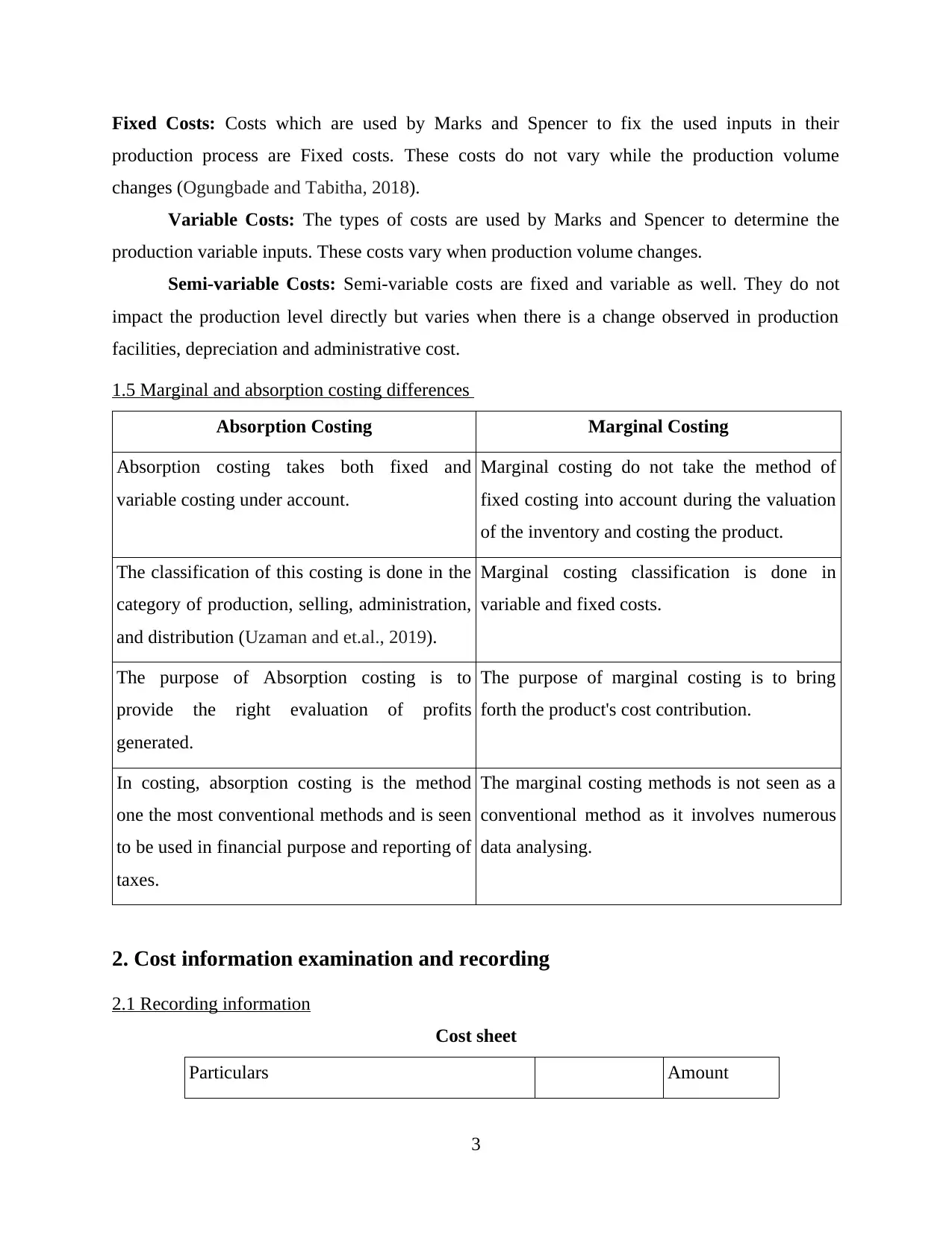
Fixed Costs: Costs which are used by Marks and Spencer to fix the used inputs in their
production process are Fixed costs. These costs do not vary while the production volume
changes (Ogungbade and Tabitha, 2018).
Variable Costs: The types of costs are used by Marks and Spencer to determine the
production variable inputs. These costs vary when production volume changes.
Semi-variable Costs: Semi-variable costs are fixed and variable as well. They do not
impact the production level directly but varies when there is a change observed in production
facilities, depreciation and administrative cost.
1.5 Marginal and absorption costing differences
Absorption Costing Marginal Costing
Absorption costing takes both fixed and
variable costing under account.
Marginal costing do not take the method of
fixed costing into account during the valuation
of the inventory and costing the product.
The classification of this costing is done in the
category of production, selling, administration,
and distribution (Uzaman and et.al., 2019).
Marginal costing classification is done in
variable and fixed costs.
The purpose of Absorption costing is to
provide the right evaluation of profits
generated.
The purpose of marginal costing is to bring
forth the product's cost contribution.
In costing, absorption costing is the method
one the most conventional methods and is seen
to be used in financial purpose and reporting of
taxes.
The marginal costing methods is not seen as a
conventional method as it involves numerous
data analysing.
2. Cost information examination and recording
2.1 Recording information
Cost sheet
Particulars Amount
3
production process are Fixed costs. These costs do not vary while the production volume
changes (Ogungbade and Tabitha, 2018).
Variable Costs: The types of costs are used by Marks and Spencer to determine the
production variable inputs. These costs vary when production volume changes.
Semi-variable Costs: Semi-variable costs are fixed and variable as well. They do not
impact the production level directly but varies when there is a change observed in production
facilities, depreciation and administrative cost.
1.5 Marginal and absorption costing differences
Absorption Costing Marginal Costing
Absorption costing takes both fixed and
variable costing under account.
Marginal costing do not take the method of
fixed costing into account during the valuation
of the inventory and costing the product.
The classification of this costing is done in the
category of production, selling, administration,
and distribution (Uzaman and et.al., 2019).
Marginal costing classification is done in
variable and fixed costs.
The purpose of Absorption costing is to
provide the right evaluation of profits
generated.
The purpose of marginal costing is to bring
forth the product's cost contribution.
In costing, absorption costing is the method
one the most conventional methods and is seen
to be used in financial purpose and reporting of
taxes.
The marginal costing methods is not seen as a
conventional method as it involves numerous
data analysing.
2. Cost information examination and recording
2.1 Recording information
Cost sheet
Particulars Amount
3
⊘ This is a preview!⊘
Do you want full access?
Subscribe today to unlock all pages.

Trusted by 1+ million students worldwide
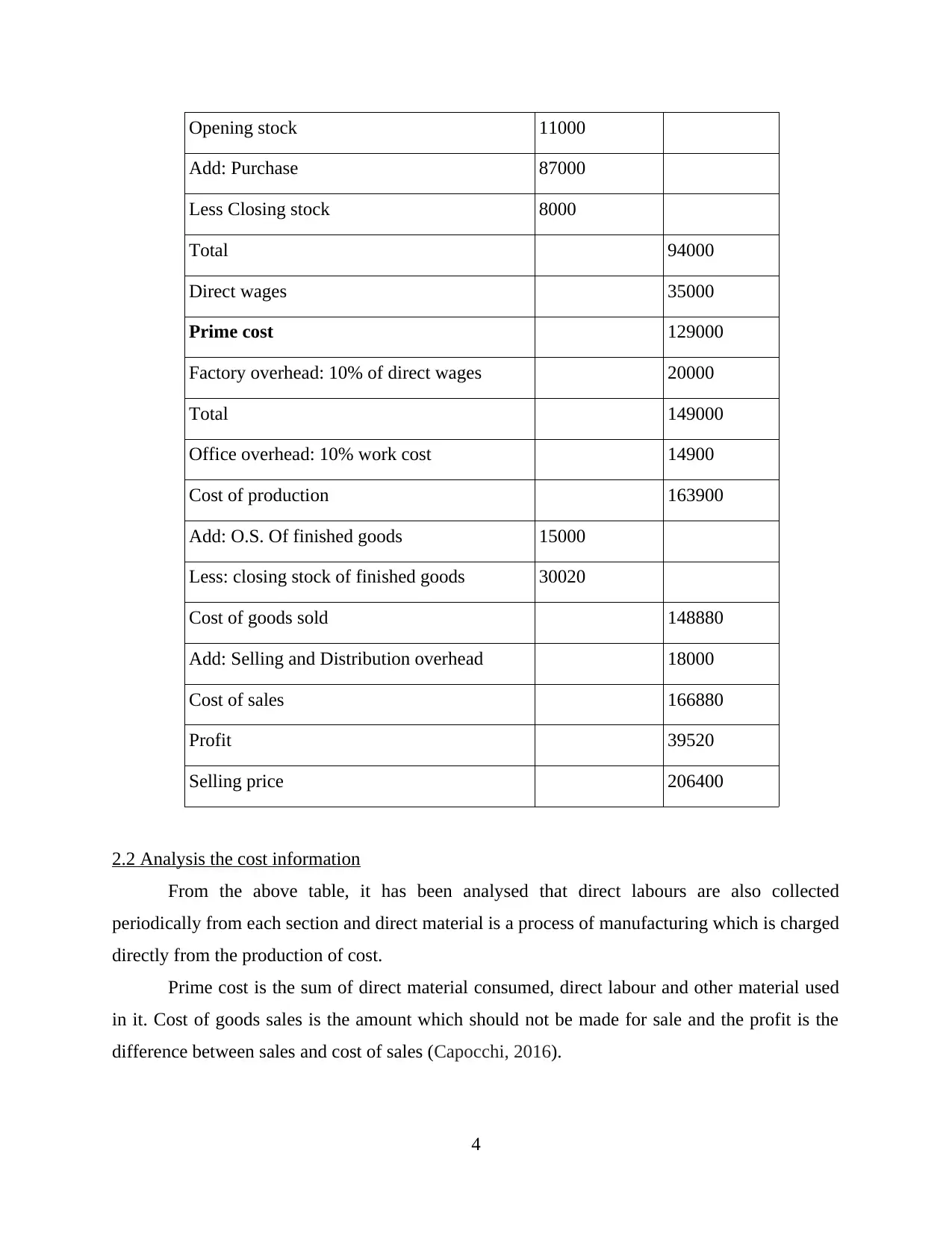
Opening stock 11000
Add: Purchase 87000
Less Closing stock 8000
Total 94000
Direct wages 35000
Prime cost 129000
Factory overhead: 10% of direct wages 20000
Total 149000
Office overhead: 10% work cost 14900
Cost of production 163900
Add: O.S. Of finished goods 15000
Less: closing stock of finished goods 30020
Cost of goods sold 148880
Add: Selling and Distribution overhead 18000
Cost of sales 166880
Profit 39520
Selling price 206400
2.2 Analysis the cost information
From the above table, it has been analysed that direct labours are also collected
periodically from each section and direct material is a process of manufacturing which is charged
directly from the production of cost.
Prime cost is the sum of direct material consumed, direct labour and other material used
in it. Cost of goods sales is the amount which should not be made for sale and the profit is the
difference between sales and cost of sales (Capocchi, 2016).
4
Add: Purchase 87000
Less Closing stock 8000
Total 94000
Direct wages 35000
Prime cost 129000
Factory overhead: 10% of direct wages 20000
Total 149000
Office overhead: 10% work cost 14900
Cost of production 163900
Add: O.S. Of finished goods 15000
Less: closing stock of finished goods 30020
Cost of goods sold 148880
Add: Selling and Distribution overhead 18000
Cost of sales 166880
Profit 39520
Selling price 206400
2.2 Analysis the cost information
From the above table, it has been analysed that direct labours are also collected
periodically from each section and direct material is a process of manufacturing which is charged
directly from the production of cost.
Prime cost is the sum of direct material consumed, direct labour and other material used
in it. Cost of goods sales is the amount which should not be made for sale and the profit is the
difference between sales and cost of sales (Capocchi, 2016).
4
Paraphrase This Document
Need a fresh take? Get an instant paraphrase of this document with our AI Paraphraser
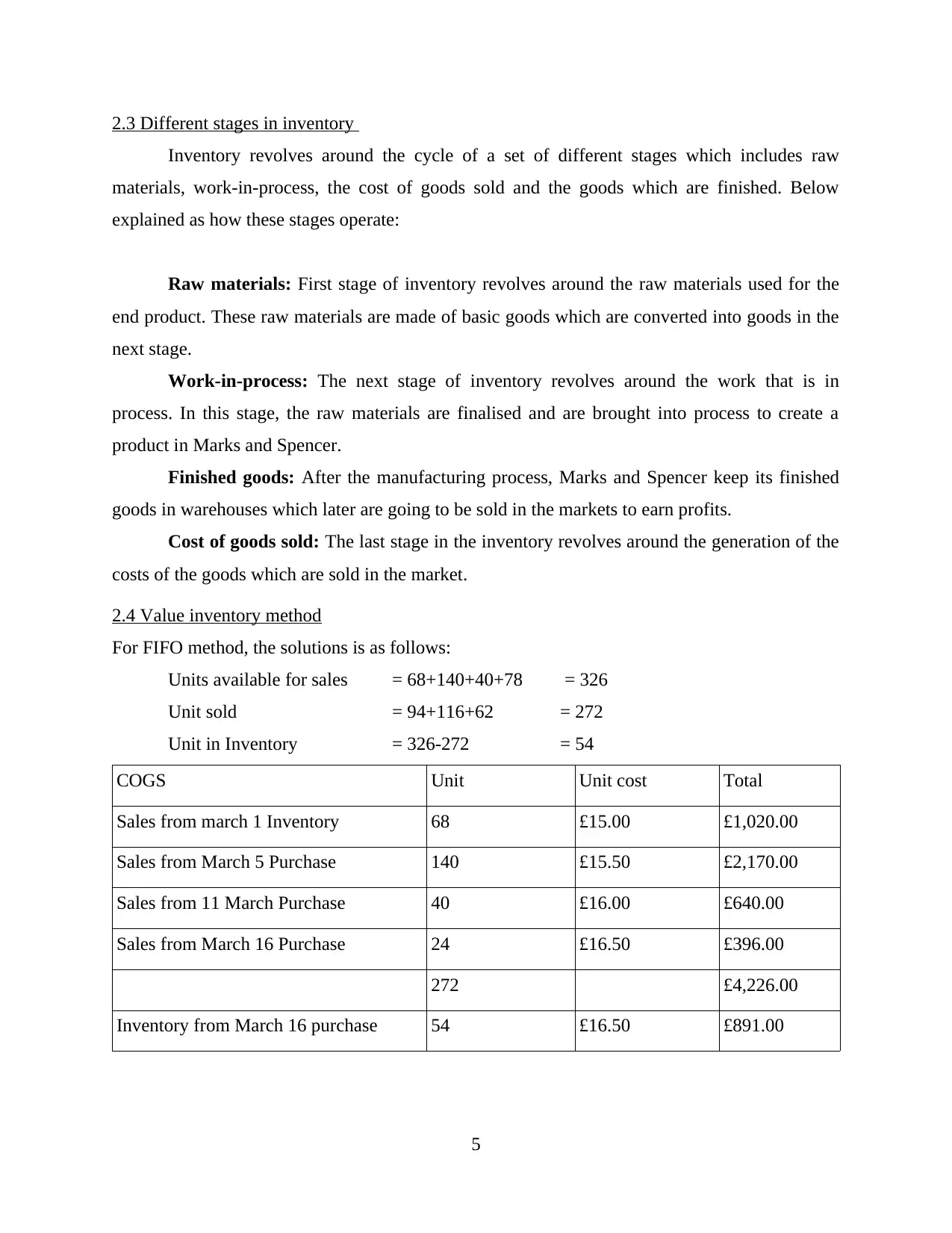
2.3 Different stages in inventory
Inventory revolves around the cycle of a set of different stages which includes raw
materials, work-in-process, the cost of goods sold and the goods which are finished. Below
explained as how these stages operate:
Raw materials: First stage of inventory revolves around the raw materials used for the
end product. These raw materials are made of basic goods which are converted into goods in the
next stage.
Work-in-process: The next stage of inventory revolves around the work that is in
process. In this stage, the raw materials are finalised and are brought into process to create a
product in Marks and Spencer.
Finished goods: After the manufacturing process, Marks and Spencer keep its finished
goods in warehouses which later are going to be sold in the markets to earn profits.
Cost of goods sold: The last stage in the inventory revolves around the generation of the
costs of the goods which are sold in the market.
2.4 Value inventory method
For FIFO method, the solutions is as follows:
Units available for sales = 68+140+40+78 = 326
Unit sold = 94+116+62 = 272
Unit in Inventory = 326-272 = 54
COGS Unit Unit cost Total
Sales from march 1 Inventory 68 £15.00 £1,020.00
Sales from March 5 Purchase 140 £15.50 £2,170.00
Sales from 11 March Purchase 40 £16.00 £640.00
Sales from March 16 Purchase 24 £16.50 £396.00
272 £4,226.00
Inventory from March 16 purchase 54 £16.50 £891.00
5
Inventory revolves around the cycle of a set of different stages which includes raw
materials, work-in-process, the cost of goods sold and the goods which are finished. Below
explained as how these stages operate:
Raw materials: First stage of inventory revolves around the raw materials used for the
end product. These raw materials are made of basic goods which are converted into goods in the
next stage.
Work-in-process: The next stage of inventory revolves around the work that is in
process. In this stage, the raw materials are finalised and are brought into process to create a
product in Marks and Spencer.
Finished goods: After the manufacturing process, Marks and Spencer keep its finished
goods in warehouses which later are going to be sold in the markets to earn profits.
Cost of goods sold: The last stage in the inventory revolves around the generation of the
costs of the goods which are sold in the market.
2.4 Value inventory method
For FIFO method, the solutions is as follows:
Units available for sales = 68+140+40+78 = 326
Unit sold = 94+116+62 = 272
Unit in Inventory = 326-272 = 54
COGS Unit Unit cost Total
Sales from march 1 Inventory 68 £15.00 £1,020.00
Sales from March 5 Purchase 140 £15.50 £2,170.00
Sales from 11 March Purchase 40 £16.00 £640.00
Sales from March 16 Purchase 24 £16.50 £396.00
272 £4,226.00
Inventory from March 16 purchase 54 £16.50 £891.00
5
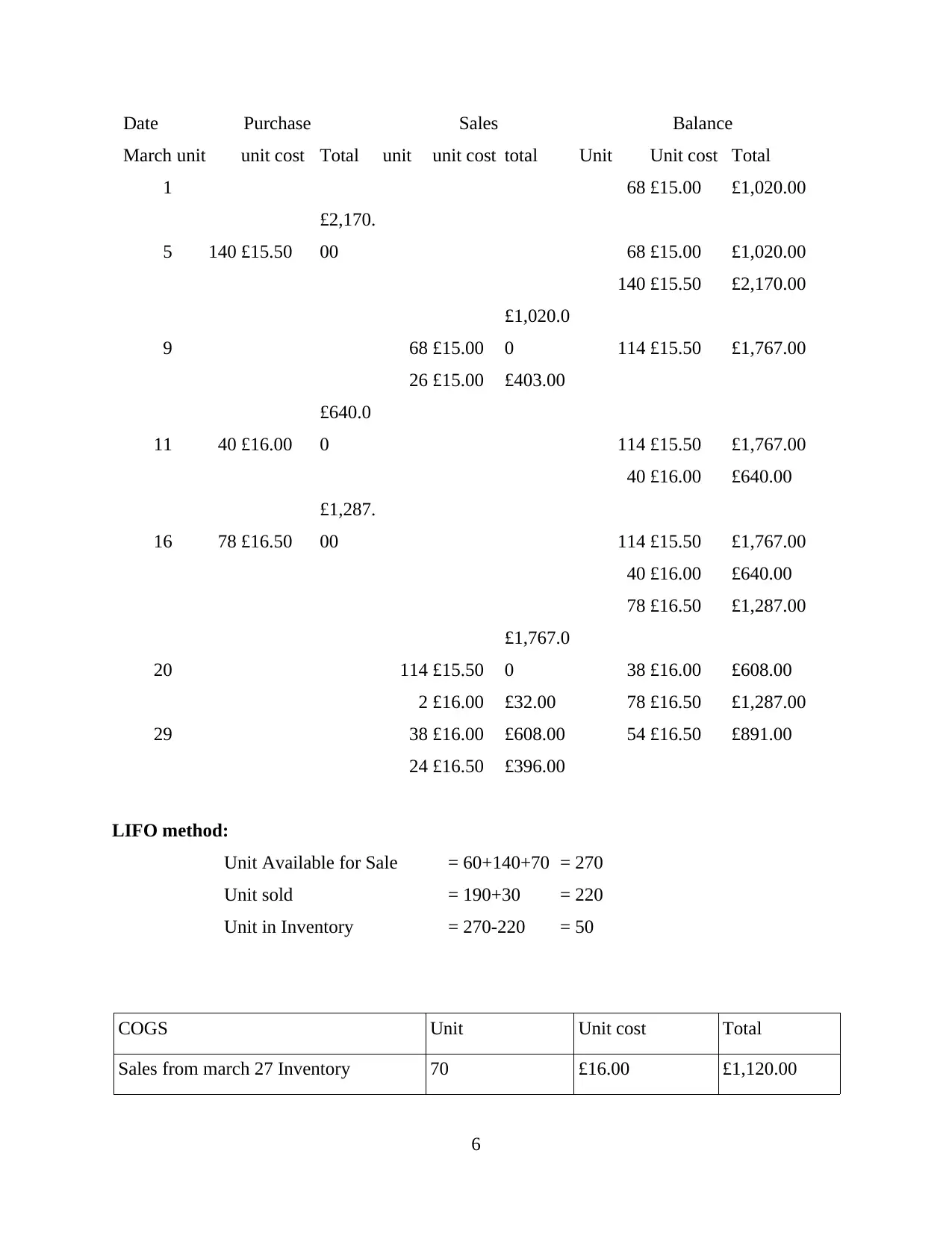
Date Purchase Sales Balance
March unit unit cost Total unit unit cost total Unit Unit cost Total
1 68 £15.00 £1,020.00
5 140 £15.50
£2,170.
00 68 £15.00 £1,020.00
140 £15.50 £2,170.00
9 68 £15.00
£1,020.0
0 114 £15.50 £1,767.00
26 £15.00 £403.00
11 40 £16.00
£640.0
0 114 £15.50 £1,767.00
40 £16.00 £640.00
16 78 £16.50
£1,287.
00 114 £15.50 £1,767.00
40 £16.00 £640.00
78 £16.50 £1,287.00
20 114 £15.50
£1,767.0
0 38 £16.00 £608.00
2 £16.00 £32.00 78 £16.50 £1,287.00
29 38 £16.00 £608.00 54 £16.50 £891.00
24 £16.50 £396.00
LIFO method:
Unit Available for Sale = 60+140+70 = 270
Unit sold = 190+30 = 220
Unit in Inventory = 270-220 = 50
COGS Unit Unit cost Total
Sales from march 27 Inventory 70 £16.00 £1,120.00
6
March unit unit cost Total unit unit cost total Unit Unit cost Total
1 68 £15.00 £1,020.00
5 140 £15.50
£2,170.
00 68 £15.00 £1,020.00
140 £15.50 £2,170.00
9 68 £15.00
£1,020.0
0 114 £15.50 £1,767.00
26 £15.00 £403.00
11 40 £16.00
£640.0
0 114 £15.50 £1,767.00
40 £16.00 £640.00
16 78 £16.50
£1,287.
00 114 £15.50 £1,767.00
40 £16.00 £640.00
78 £16.50 £1,287.00
20 114 £15.50
£1,767.0
0 38 £16.00 £608.00
2 £16.00 £32.00 78 £16.50 £1,287.00
29 38 £16.00 £608.00 54 £16.50 £891.00
24 £16.50 £396.00
LIFO method:
Unit Available for Sale = 60+140+70 = 270
Unit sold = 190+30 = 220
Unit in Inventory = 270-220 = 50
COGS Unit Unit cost Total
Sales from march 27 Inventory 70 £16.00 £1,120.00
6
⊘ This is a preview!⊘
Do you want full access?
Subscribe today to unlock all pages.

Trusted by 1+ million students worldwide
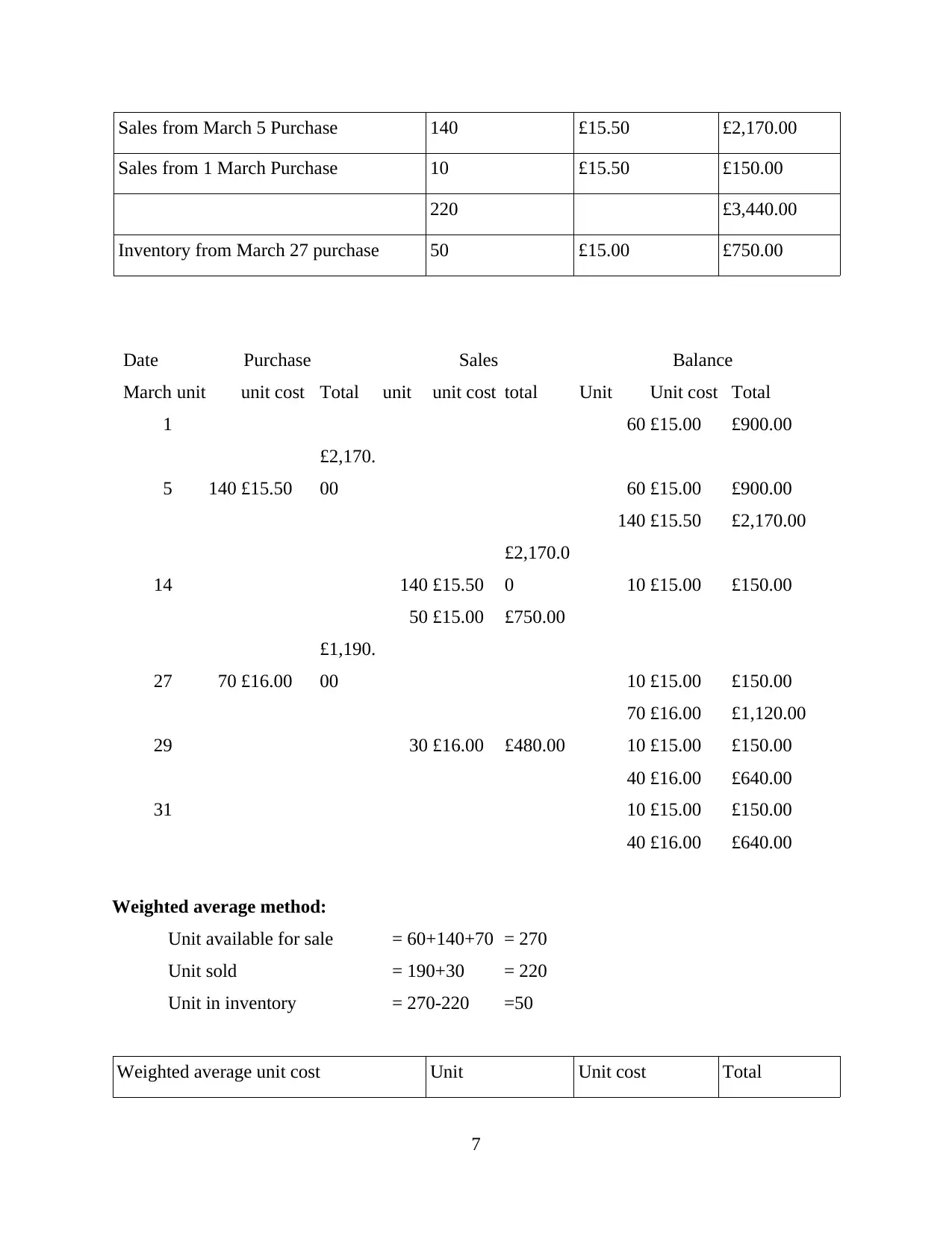
Sales from March 5 Purchase 140 £15.50 £2,170.00
Sales from 1 March Purchase 10 £15.50 £150.00
220 £3,440.00
Inventory from March 27 purchase 50 £15.00 £750.00
Date Purchase Sales Balance
March unit unit cost Total unit unit cost total Unit Unit cost Total
1 60 £15.00 £900.00
5 140 £15.50
£2,170.
00 60 £15.00 £900.00
140 £15.50 £2,170.00
14 140 £15.50
£2,170.0
0 10 £15.00 £150.00
50 £15.00 £750.00
27 70 £16.00
£1,190.
00 10 £15.00 £150.00
70 £16.00 £1,120.00
29 30 £16.00 £480.00 10 £15.00 £150.00
40 £16.00 £640.00
31 10 £15.00 £150.00
40 £16.00 £640.00
Weighted average method:
Unit available for sale = 60+140+70 = 270
Unit sold = 190+30 = 220
Unit in inventory = 270-220 =50
Weighted average unit cost Unit Unit cost Total
7
Sales from 1 March Purchase 10 £15.50 £150.00
220 £3,440.00
Inventory from March 27 purchase 50 £15.00 £750.00
Date Purchase Sales Balance
March unit unit cost Total unit unit cost total Unit Unit cost Total
1 60 £15.00 £900.00
5 140 £15.50
£2,170.
00 60 £15.00 £900.00
140 £15.50 £2,170.00
14 140 £15.50
£2,170.0
0 10 £15.00 £150.00
50 £15.00 £750.00
27 70 £16.00
£1,190.
00 10 £15.00 £150.00
70 £16.00 £1,120.00
29 30 £16.00 £480.00 10 £15.00 £150.00
40 £16.00 £640.00
31 10 £15.00 £150.00
40 £16.00 £640.00
Weighted average method:
Unit available for sale = 60+140+70 = 270
Unit sold = 190+30 = 220
Unit in inventory = 270-220 =50
Weighted average unit cost Unit Unit cost Total
7
Paraphrase This Document
Need a fresh take? Get an instant paraphrase of this document with our AI Paraphraser
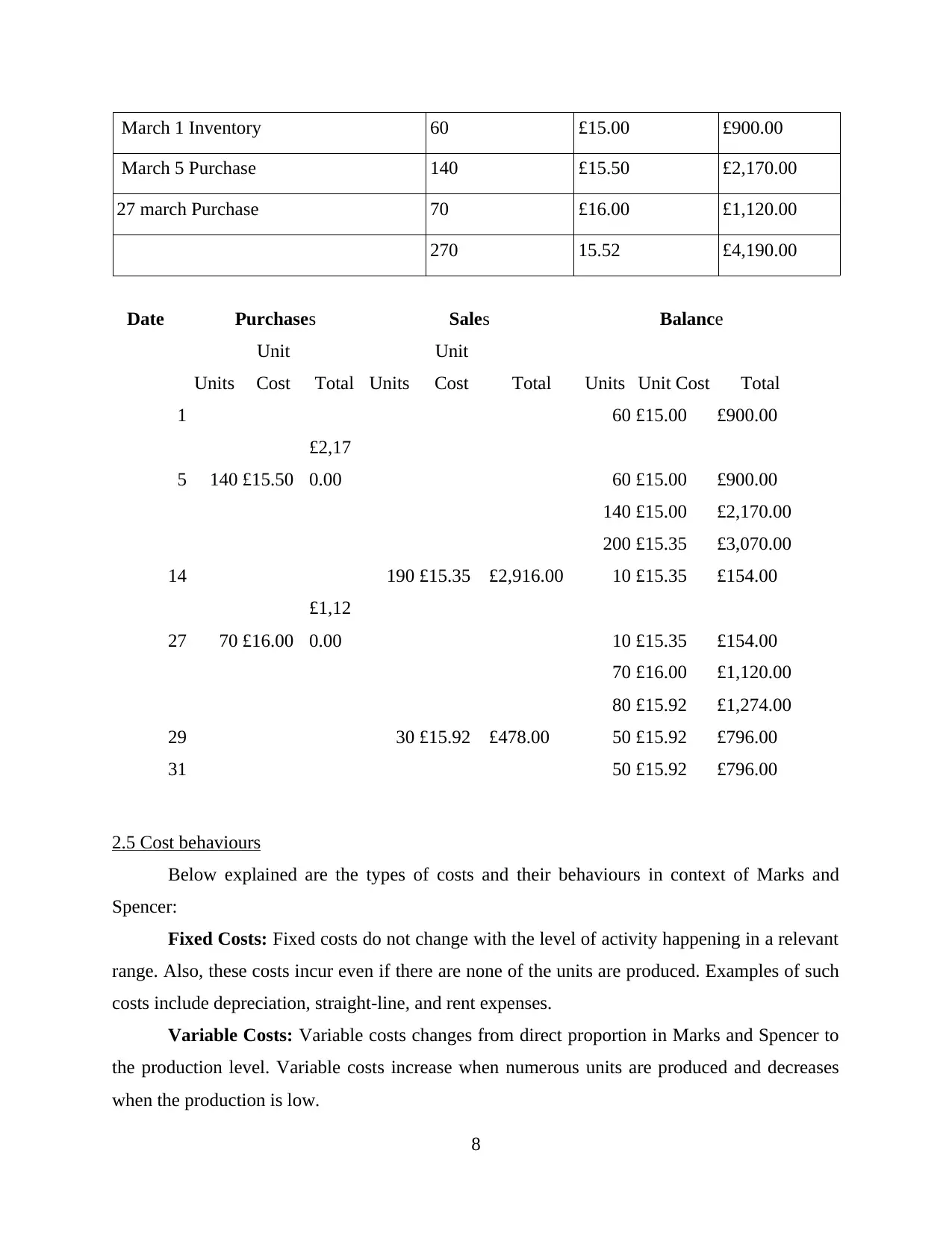
March 1 Inventory 60 £15.00 £900.00
March 5 Purchase 140 £15.50 £2,170.00
27 march Purchase 70 £16.00 £1,120.00
270 15.52 £4,190.00
Date Purchases Sales Balance
Units
Unit
Cost Total Units
Unit
Cost Total Units Unit Cost Total
1 60 £15.00 £900.00
5 140 £15.50
£2,17
0.00 60 £15.00 £900.00
140 £15.00 £2,170.00
200 £15.35 £3,070.00
14 190 £15.35 £2,916.00 10 £15.35 £154.00
27 70 £16.00
£1,12
0.00 10 £15.35 £154.00
70 £16.00 £1,120.00
80 £15.92 £1,274.00
29 30 £15.92 £478.00 50 £15.92 £796.00
31 50 £15.92 £796.00
2.5 Cost behaviours
Below explained are the types of costs and their behaviours in context of Marks and
Spencer:
Fixed Costs: Fixed costs do not change with the level of activity happening in a relevant
range. Also, these costs incur even if there are none of the units are produced. Examples of such
costs include depreciation, straight-line, and rent expenses.
Variable Costs: Variable costs changes from direct proportion in Marks and Spencer to
the production level. Variable costs increase when numerous units are produced and decreases
when the production is low.
8
March 5 Purchase 140 £15.50 £2,170.00
27 march Purchase 70 £16.00 £1,120.00
270 15.52 £4,190.00
Date Purchases Sales Balance
Units
Unit
Cost Total Units
Unit
Cost Total Units Unit Cost Total
1 60 £15.00 £900.00
5 140 £15.50
£2,17
0.00 60 £15.00 £900.00
140 £15.00 £2,170.00
200 £15.35 £3,070.00
14 190 £15.35 £2,916.00 10 £15.35 £154.00
27 70 £16.00
£1,12
0.00 10 £15.35 £154.00
70 £16.00 £1,120.00
80 £15.92 £1,274.00
29 30 £15.92 £478.00 50 £15.92 £796.00
31 50 £15.92 £796.00
2.5 Cost behaviours
Below explained are the types of costs and their behaviours in context of Marks and
Spencer:
Fixed Costs: Fixed costs do not change with the level of activity happening in a relevant
range. Also, these costs incur even if there are none of the units are produced. Examples of such
costs include depreciation, straight-line, and rent expenses.
Variable Costs: Variable costs changes from direct proportion in Marks and Spencer to
the production level. Variable costs increase when numerous units are produced and decreases
when the production is low.
8
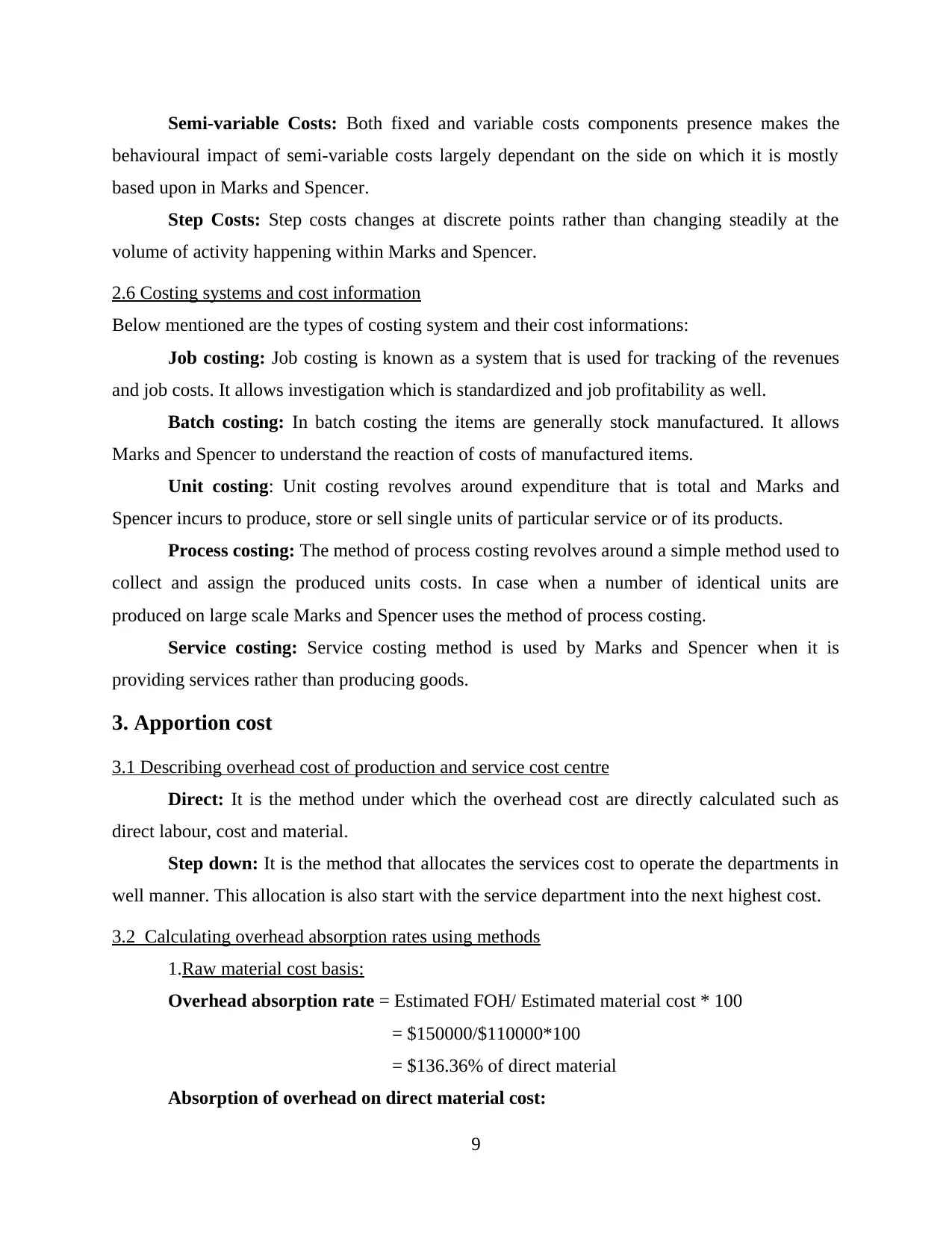
Semi-variable Costs: Both fixed and variable costs components presence makes the
behavioural impact of semi-variable costs largely dependant on the side on which it is mostly
based upon in Marks and Spencer.
Step Costs: Step costs changes at discrete points rather than changing steadily at the
volume of activity happening within Marks and Spencer.
2.6 Costing systems and cost information
Below mentioned are the types of costing system and their cost informations:
Job costing: Job costing is known as a system that is used for tracking of the revenues
and job costs. It allows investigation which is standardized and job profitability as well.
Batch costing: In batch costing the items are generally stock manufactured. It allows
Marks and Spencer to understand the reaction of costs of manufactured items.
Unit costing: Unit costing revolves around expenditure that is total and Marks and
Spencer incurs to produce, store or sell single units of particular service or of its products.
Process costing: The method of process costing revolves around a simple method used to
collect and assign the produced units costs. In case when a number of identical units are
produced on large scale Marks and Spencer uses the method of process costing.
Service costing: Service costing method is used by Marks and Spencer when it is
providing services rather than producing goods.
3. Apportion cost
3.1 Describing overhead cost of production and service cost centre
Direct: It is the method under which the overhead cost are directly calculated such as
direct labour, cost and material.
Step down: It is the method that allocates the services cost to operate the departments in
well manner. This allocation is also start with the service department into the next highest cost.
3.2 Calculating overhead absorption rates using methods
1.Raw material cost basis:
Overhead absorption rate = Estimated FOH/ Estimated material cost * 100
= $150000/$110000*100
= $136.36% of direct material
Absorption of overhead on direct material cost:
9
behavioural impact of semi-variable costs largely dependant on the side on which it is mostly
based upon in Marks and Spencer.
Step Costs: Step costs changes at discrete points rather than changing steadily at the
volume of activity happening within Marks and Spencer.
2.6 Costing systems and cost information
Below mentioned are the types of costing system and their cost informations:
Job costing: Job costing is known as a system that is used for tracking of the revenues
and job costs. It allows investigation which is standardized and job profitability as well.
Batch costing: In batch costing the items are generally stock manufactured. It allows
Marks and Spencer to understand the reaction of costs of manufactured items.
Unit costing: Unit costing revolves around expenditure that is total and Marks and
Spencer incurs to produce, store or sell single units of particular service or of its products.
Process costing: The method of process costing revolves around a simple method used to
collect and assign the produced units costs. In case when a number of identical units are
produced on large scale Marks and Spencer uses the method of process costing.
Service costing: Service costing method is used by Marks and Spencer when it is
providing services rather than producing goods.
3. Apportion cost
3.1 Describing overhead cost of production and service cost centre
Direct: It is the method under which the overhead cost are directly calculated such as
direct labour, cost and material.
Step down: It is the method that allocates the services cost to operate the departments in
well manner. This allocation is also start with the service department into the next highest cost.
3.2 Calculating overhead absorption rates using methods
1.Raw material cost basis:
Overhead absorption rate = Estimated FOH/ Estimated material cost * 100
= $150000/$110000*100
= $136.36% of direct material
Absorption of overhead on direct material cost:
9
⊘ This is a preview!⊘
Do you want full access?
Subscribe today to unlock all pages.

Trusted by 1+ million students worldwide
1 out of 18
Related Documents
Your All-in-One AI-Powered Toolkit for Academic Success.
+13062052269
info@desklib.com
Available 24*7 on WhatsApp / Email
![[object Object]](/_next/static/media/star-bottom.7253800d.svg)
Unlock your academic potential
Copyright © 2020–2025 A2Z Services. All Rights Reserved. Developed and managed by ZUCOL.





